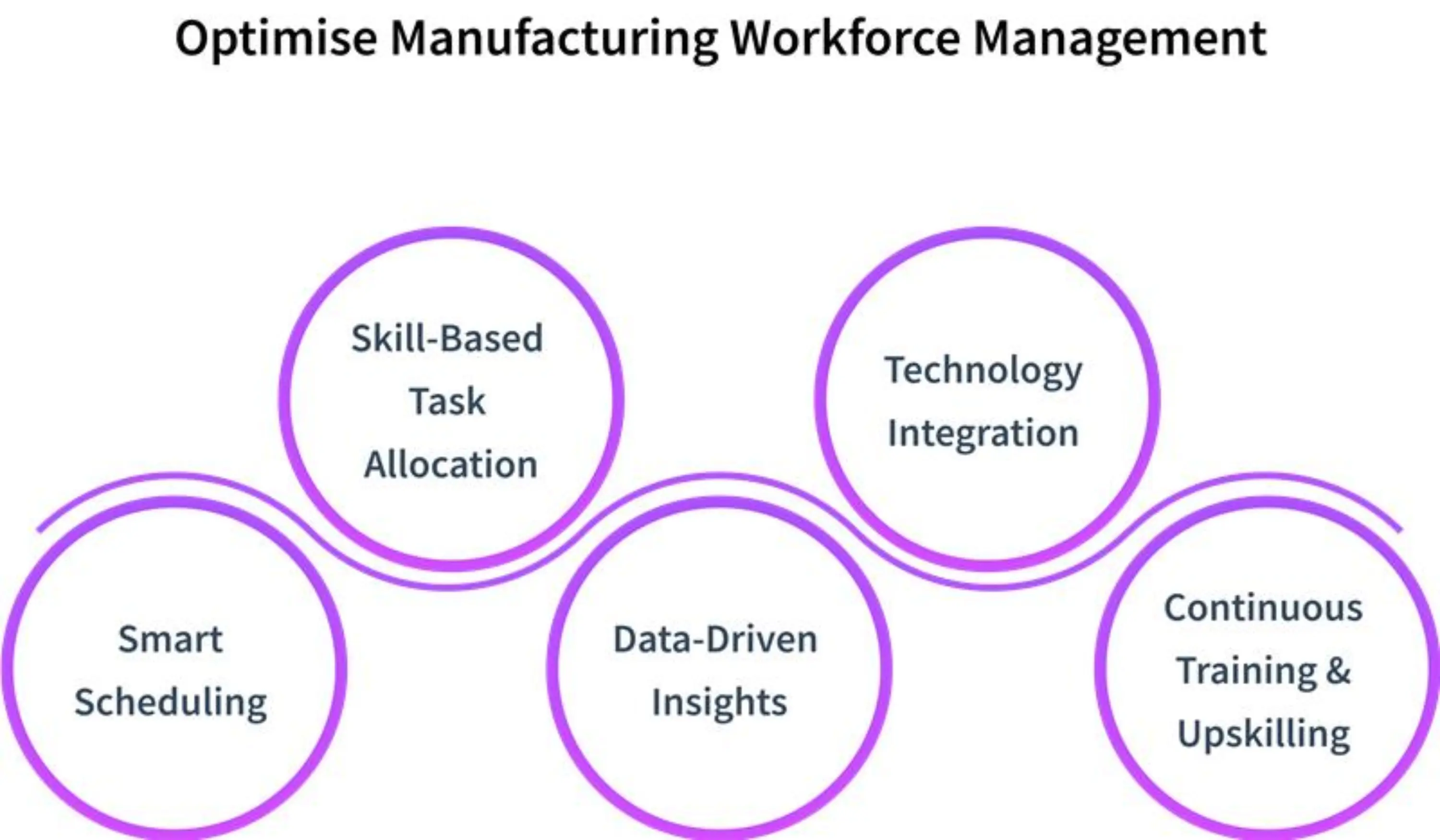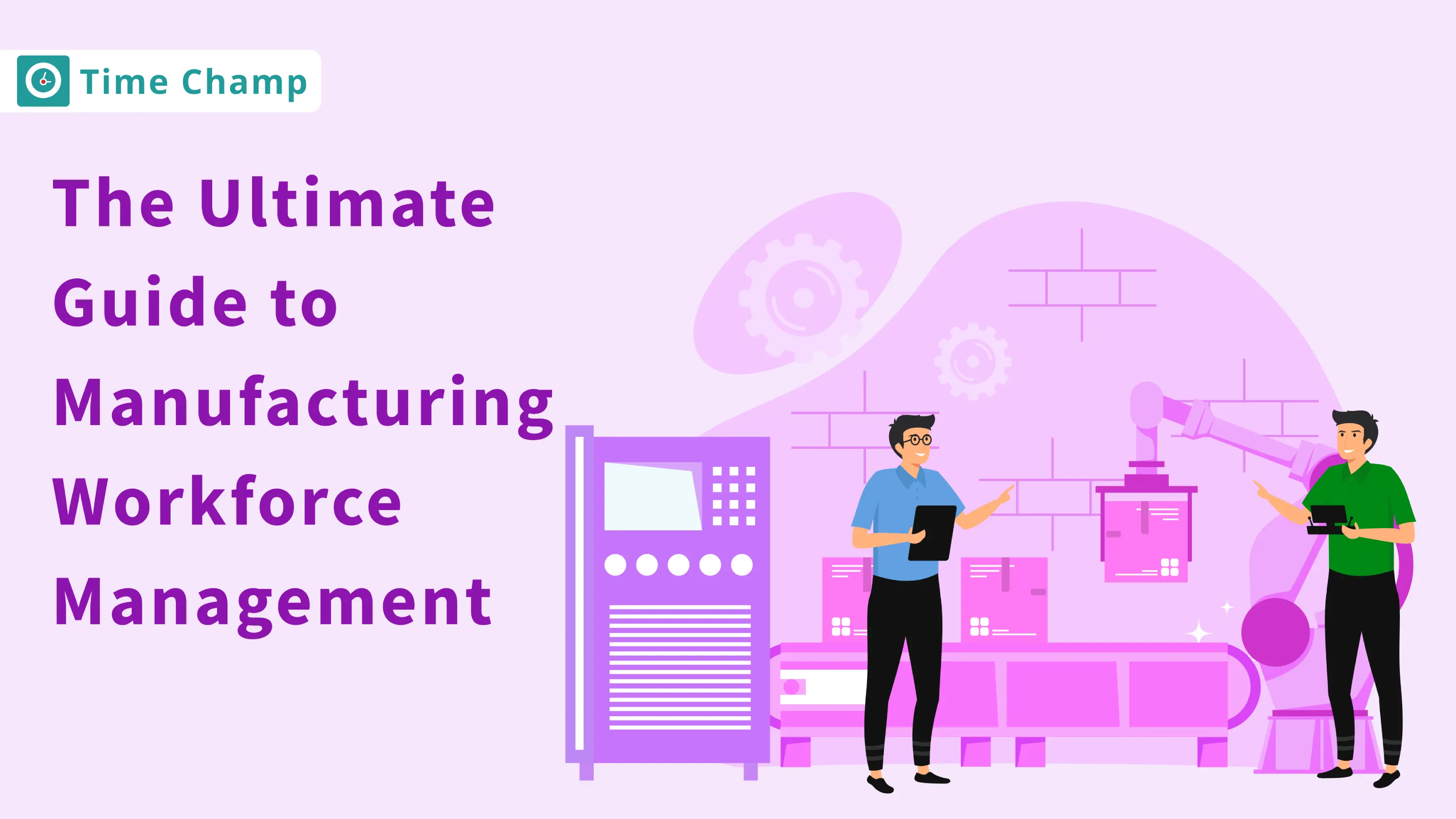Running a manufacturing workforce today is more than tracking attendance or filling shift gaps. You’re juggling productivity targets, labour costs, compliance, safety standards, and employee satisfaction , all while keeping production on schedule. Without the right approach, small disruptions can quickly turn into expensive setbacks.
This blog breaks down what manufacturing workforce management looks like in 2025, why it’s essential, the most common challenges, how to measure efficiency, and the strategies and tools that top manufacturers are using to stay ahead. By the end, you’ll know how to streamline operations, optimise staffing, and build a more engaged and reliable workforce.
What Is Manufacturing Workforce Management?
Manufacturing workforce management is the systematic procedure of planning, scheduling, monitoring and optimisation of employees in the manufacturing industry to boost productivity , control labour expenses, compliance and staffing to match dynamic production needs.
Workforce management in the manufacturing sector includes scheduling shifts, tracking attendance, assigning tasks based on skills and performance monitoring . Through manufacturing workforce management software, organisations can facilitate these processes, minimise operational inefficiencies, and increase workforce stability. According to a survey conducted by Deloitte in 2025 about Smart Manufacturing, manufacturers claimed that their employee productivity has improved by 7-20% following sophisticated workforce optimisation measures.
Workforce management goes beyond day-to-day operations. It assists manufacturers in developing a trusted workforce, enhancing employee engagement and lowering turnover. With the growing challenges, such as skills shortages and unpredictable demand, adopting data-driven workforce strategies is key to ensuring long-term efficiency and business sustainability.
Why Is Workforce Management Important in Manufacturing?
Workforce management is crucial in assisting manufacturers to strike a balance between productivity, labour expenses, compliance, and employee satisfaction. A balanced workforce means that the operations are efficient, even in times of varying demand or skills.
Improves Productivity
Workforce management matches production requirements to the staffing levels, reducing downtime and enhancing output. Studies by OliverWyman indicate that proper scheduling has the potential to increase plant productivity up to 25%.
Cost Control
One of the largest cost drivers in manufacturing is labour, which can account for 16–30% of total production costs depending on the industry. Effective manufacturing workforce management helps minimise overtime, reduce absenteeism, and optimise shift allocation directly, lowering operational expenses and improving margins.
Employee Engagement
Equal scheduling and task-distribution based on skills enhances the engagement, which has a direct effect on profitability. According to Gallup , organisations that have engaged employees record 21% higher profitability.
Regulatory Compliance
The management of the manufacturing workforce guarantees compliance with labour laws, union contracts and safety in the workplace and prevents expensive fines. By standardising processes and maintaining accurate digital records, organisations can also simplify audits and reduce legal risks.
Adaptability to Market Demands
As demand cycles change, proper management of the workforce facilitates quick adaptation in staffing to ensure that production is aligned with the customers. This flexibility allows manufacturers to respond faster to seasonal fluctuations and sudden shifts in customer expectations.
How to Optimise Manufacturing Workforce

The process of optimising the manufacturing workforce involves matching employee skills, schedules, and productivity with the production objectives. Through workforce optimisation practices, manufacturers are able to streamline their operations, cut costs, and remain consistent even when their demand is fluctuating.
Smart Scheduling
Intelligent scheduling systems enable managers to match the availability of the workforce with production peaks and seasonal needs. This minimises overstaffing, idle time, and facilitates smooth operations.
Skill-Based Task Allocation
The allocation of jobs according to the strengths of employees enhances the quality of output. Workforce optimisation is about ensuring that the right skills are paired with the right tasks to achieve more efficiency.
Data-Driven Insights
Workforce management based on analytics offers insight into productivity trends, absenteeism, and labor usage. The real-time dashboards enable managers to detect areas of performance and respond promptly.
Technology Integration
The implementation of manufacturing workforce management software will allow employee productivity , attendance, and shift compliance to be monitored in real-time. This makes sure that performance bottlenecks are effectively resolved.
Continuous Training & Upskilling
The future of the workforce must be developed through continuous skills enhancement. Time Champ’s reports can identify gaps in the skills of employees and assist organisations in bridging the gap effectively.
How to Measure Workforce Efficiency in Manufacturing
Workforce efficiency in manufacturing should be measured in order to strike a balance between productivity, quality, and cost-effectiveness. Monitoring performance using effective metrics allows manufacturers to recognise bottlenecks, minimise downtime, and implement evidence-based changes to stay competitive.
1. Overall Equipment Effectiveness (OEE)
OEE evaluates how effectively manufacturing resources are utilised by taking into consideration some factors such as availability, performance, and quality. The high score of OEE is an indication of low downtime, short processing cycles, and low defects. Studies by leanproduction have shown that an 85% OEE is viewed as best-in-class for discrete manufacturers.
2. Labour Productivity Metrics
Labour productivity is computed in terms of output per worker or labour hour, enabling manufacturers to calculate the efficiency with which employees translate effort into output. Monitoring this over time reveals areas of skills deficiency and training requirements. The U.S. Bureau of Labor Statistics reports that labour productivity in manufacturing increased 2.7% in 2023, indicating that technology and optimisation affect efficiency.
3. Employee Turnover and Retention
High turnover is inefficient because it raises the costs of hiring and diminishes the stability of the workforce. The rate of turnover can be utilised to monitor the sustainability of workforce strategies. According to a survey by Gallup , unplanned absenteeism costs employers in the U.S. an amount of $2,660 per employee per year.
4. Quality Output Metrics
Efficiency is about speed and producing high-quality goods. Monitoring the rate of defects, proportion of rework, and customer returns indicates the level at which employees can maintain the standards of the products. ASQ estimates that corporations that are well-managed in quality, save up to 15-20% of overall production expenses.
5. Employee Turnover and Retention
High turnover interferes with efficiency because it increases the costs of training and decreases the stability of the workforce. Monitoring turnover is used to determine workforce health. According to Deloitte , 83% of manufacturers struggle to retain talent because of skills gaps and competition.
What Are the Benefits of Effective Manufacturing Workforce Management?
There are various benefits that good workforce management brings to manufacturers. These advantages help in streamlining operations, minimising waste, and supporting employees and organisational development.
Boosts Productivity and Performance
Scheduling, PTO, and other work-related tasks are automated to allow managers and employees to concentrate on work that is valuable according to the production process. Having clear performance metrics assists in monitoring improvements and bridging gaps.
Reduces Labour Costs
Accurate forecasting, more optimised scheduling and prevention of overstaffing ensure that unnecessary labour costs are reduced. The savings achieved can be invested back into training or equipment.
Greater Operational Agility
A responsive workforce management approach enables manufacturers to scale up and down, make adjustments on shifts, and react to changes in the supply chain or demand surges.
Improves Time & Attendance Accuracy
Accurate time tracking solutions eliminate payroll and policy compliance mistakes. Regular monitoring of attendance also assists in the early detection and correction of absenteeism.
Higher Employee Satisfaction & Retention
Providing employees with clarity of schedules, flexibility where applicable, and equitable workload distribution enhances morale. Satisfied employees are less likely to leave, leading to greater workforce stability.
What Are the key Challenges of Managing a Manufacturing Workforce?
Management of a manufacturing workforce is a complicated process because it entails balancing employee performance, compliance and costs with dynamic production requirements. The following are some of the major challenges that organisations encounter in this sector.
1. Skills Gap and Shortages
The rise of automation, robotics, and intelligent manufacturing demands highly technical employees. Nevertheless, numerous manufacturers face the challenges of hiring and keeping talented employees, which leads to an increasing skill shortage.
2. High Turnover Rates
High employee turnover is usually due to demanding work environments and competitive labour markets. This interferes with operations, raises recruiting expenses, and affects the stability of the long-term workforce.
3. Compliance and Safety Management
Manufacturers operate under strict labour, environmental and safety laws. Ensuring compliance and maintaining productivity can be challenging, and failing to follow safety protocols can result in accidents or financial penalties.
4. Absenteeism and Attendance Issues
Regular absences directly impact production schedules and team efficiency. Identifying and addressing attendance patterns is crucial for maintaining continuous workflow.
5. Controlling Labour Costs
One of the challenges to be addressed repeatedly is to balance staffing, overtime, and wage compliance. Lack of efficiency in labour cost management can easily lower profitability in a tight-margin industry.
6. Adapting to Fluctuating Demand
The demand in manufacturing can be affected by supply chain disruptions, seasonal changes or unexpected shifts in customer orders. The issue of adjusting the workforce capacity to accommodate these changes without overstaffing is critical.
How to Choose the Right Manufacturing Workforce Management Software
The selection of the appropriate manufacturing workforce management software will help increase productivity, reduce expenses, and maintain compliance with operations. The appropriate system must make scheduling easier, increase visibility, and respond to evolving workforce and production requirements.
1. Core Features and Functionality
An effective manufacturing workforce management software should offer shift scheduling to match production demand with staffing. It must incorporate time and attendance tracking to ensure proper payroll and compliance. Finally, performance monitoring tools help in highlighting gaps in efficiency and optimising workforce performance.
2. Integration with Existing Systems
Seamless integration with ERP platforms ensures smooth data flow across both finance and operations. Connection to the HR and payroll systems minimises redundancy and inaccuracies. Also, it is compatible with warehouse workforce management systems to enhance end-to-end visibility and coordination.
3. Scalability and Flexibility
The software must be able to scale with the increase in the workforce without necessitating a costly upgrade. Manufacturing requires flexibility to increase or decrease staffing in peak seasons. It must also serve several locations or warehouses, which makes it appropriate to scale up operations.
4. User Experience and Accessibility
A user-friendly interface promotes rapid adoption among teams. Mobile accessibility allows employees and managers to view schedules and updates anytime, anywhere. Simple self-service capabilities decrease administrative burden and employee empowerment.
5. Data and Analytics Capabilities
Powerful analytics offer real-time information about productivity and labour costs. Measures such as absenteeism and overtime are tracked to determine inefficiencies. Predictive forecasting tools enable managers to make data-driven decisions regarding staffing.
6. Vendor Support and Security
Customer support is reliable, so that problems are solved within a short time. Periodic software upgrades ensure that the system is aligned with changing manufacturing requirements. Strong data security measures safeguard confidential employee and business data.
Conclusion
Manufacturing workforce management is critical to productivity, compliance, and labour cost management. Modern manufacturing workforce management software allows businesses to address issues like skills shortage, high turnover, and demand fluctuations as well as enhance employee engagement and operational agility.
With the implementation of a data-driven strategy and using the appropriate digital tools, manufacturers are able to develop a strong workforce that can adjust to the shifting market demands. Organisations investing in workforce management practices that are effective not only increase efficiency but also ensure a long-term competitive edge.
Frequently Asked Questions
Workforce management deals with day-to-day activities such as scheduling and attendance, whereas HRM deals with hiring, policies, and employee development.
Yes, it reduces unnecessary overtime and labour costs by predicting its staffing requirements and automating its shifts.
Workforce management systems are used by manufacturers to monitor certifications, adhere to labour laws, and ensure safety standards.
Key metrics include OEE (Overall Equipment Effectiveness), labour productivity, attendance, quality output, and turnover rates, helping organisations gauge overall workforce efficiency.









